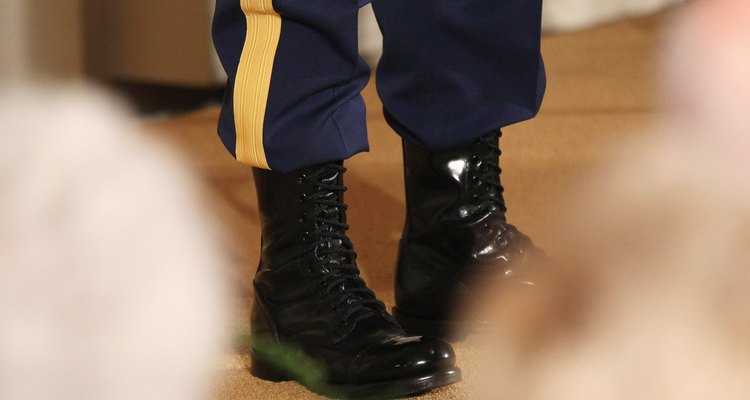
Chip Somodevilla/Getty Images News/Getty Images
Corcoran footwear has long been the choice of military professionals, but like most leather work boots, they are not comfortable right out of the box. New recruits enduring long hours of marching and running sometimes find themselves regretting not breaking in their Cocoran boots before arriving at basic training. With blisters and calluses forming on their feet, these novices are left desperately searching for a secret way to break in the boots faster. Unfortunately, nothing is as effective as just wearing the boots every day, so you should allot some time before basic training begins to break them in.
You and Your New Boots Should Be Inseparable
According to Kristin Hostetter, a contributing editor for Backpacker magazine, you should take your new boots out of the box and start wearing them around your home right away. Wear them while you do the laundry, wash the dishes, make sandwiches for lunch and change the light bulbs in your lamps. You need to do this for two days, and during that time, you need to make sure that the boots fit correctly. If the fit is not right, you can expect that painful blisters will already be forming on your feet.
After you have worn them around the house for two days and decided that the fit is correct, you should start taking them on errands outside of the house. For example, take your new boots to the hardware store to get some new tools or lumber. If you are a parent, wear them to pick up your kids from school. You should even take your new boots out to dinner, provided it is not a restaurant that requires a suit jacket.
After your boots have done errand duty for three days, you might find a few hot spots that are starting to rub your skin raw. The solution is to apply leather softener to the offending areas of the boot. Refrain from applying the softener to the entire boot because if the leather on the ankle and heel gets too soft, the boot will offer no support and put you at risk for injury. If a blister has already formed, clean the blister and put moleskin over it to prevent further irritation or infection.
Now is time to start taking them on hikes. If your purchased Corcoran boots for use in the military, you should also start jogging in your boots as that will be a requirement during training. Eventually, your persistence will pay off and the boots will mold to fit your feet.
Avoid the Shower and the Oven
A single internet search yields a variety of quick-fixes for breaking in boots, most of which require placing your boots in an oven or a shower. Excessive heat can cause the glue to come apart, leaving you with parts of a boot that have to be reassembled. And before you completely submerge those boots in water, consider that a leather repair company called The Leather Solution claims that water dries out leather, which can cause the leather to crack. In short, applying excessive heat or water to your brand-new boots is a bad idea, unless you have extra money to spend on a second pair.
Related Articles

How to Soften Doc Marten Boots

How to Loosen up Army Boots That Are ...
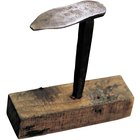
How to Replace a Sole on a Timberland ...

How to Soak New Boots in Water
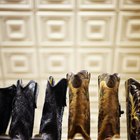
How to Make Cowboy Boots Softer

How to Get My Boots to Stop Squeaking
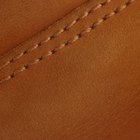
How to Replace Soles on Red Wing Boots

It Hurts Inside of My Shoes: How Can I ...

How to Shrink Leather Boots

How to Oil Your New Boots in an Oven

How to Break in Red Wing Leather Boots
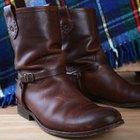
How to Care for Frye Boots
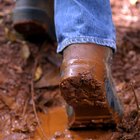
How to Break In New Danner Leather Work ...

How to Repair Cracked Lizard Boots

How to Fix the Sole of Boots That Are ...
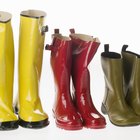
How to Fix Cracked Rubber Boots

How to Care for Asolo Leather Hiking ...

How to Replace Ugg Zippers

How to Get Rid of Creases in Timberland ...

How to Prepare UGG Boots for First Time ...
References
- ArmyStudyGuide.com: Use and Care Instructions Army Combat Boot (Hot Weather)
- Backpacker magazine: Know Your Goop; Steve George; Aug. 1997
Writer Bio
Samantha Herman earned an undergraduate degree in journalism from Northern Arizona University in 2005. Her professional writing career started in 2008, when she accepted an internship at "Willamette Week," a local alternative publication. Upon completing her internship, she became employed as a copywriter for an internet media company. In addition to copywriting, she has written articles for PDX Pipeline and eHow.
Photo Credits
Chip Somodevilla/Getty Images News/Getty Images